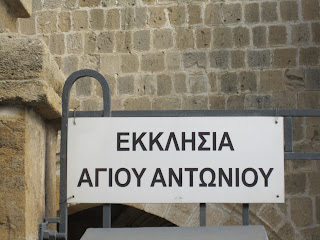I think I need more pictures and fewer words on this blog. The trick is how to do that, but I am learning. This posting is an experiment in adding more pictures with concise descriptions. Bear with me, please, as I enter more fully into the technology of the day....
I passed this site on the way to the open air market on Saturday morning. The excavation of antiquities appears to be happening with little fanfare. No signs marked the activity, so I am assuming it is some sort of archeological exploration. The Department of Antiquities regulates construction on any sites where ancient remains, archeological and human, are located. And in Nicosia, that is almost everywhere. Yesterday, I heard a young man working with an NGP called Peace Players describe their goal of building a basketball court in the moat area around the wall, and of being thwarted by the Department of Antiquities. The tall building in the background captures the dilemma of this city---ancient and modern, even postmodern, living side-by-side. As one Cypriot said, "Cyprus moved from pre-modern to post-modern with very little in between." The constast is startling and is evident in more than just sites like this.
Another interesting view, walking along the wall of the Old City. This structure appears to be quite old, but nothing marks it or describes what it is. The Cypriot-American driving the car as we passed said, "Someday I'm going to find out what that is. I thought maybe aquaduct, but when I climbed on top, nothing was there." He is clearly more agile and adventurous than I, but I wanted to climb on top to see what it is, too! A walking tour of the old city is available, and next Thursday, I will join it to see what I can learn. Expect more pictures and informed documentary to come!
This is the outside of the grocery nearest my house. The stonework in the lower part shows the beginning of the renovation being done. I'll take a picture later to show the finished product. This gives a good sense of the atmosphere in the Old City. Pockets of renovation interspersed among a lot of older structures in need of repair. Inside, the store occupies five small rooms, with most everything you need for food and basic survival. My first Cypriot shopping excursion. This is in sharp contrast to the "Alpha and Omega" store in Engomi, a nearby surburb of Nicosia, where a Wallmart atmosphere offers whatever you want, as the name suggests. I didn't take a picture of that, since it would look like any other big store I would find in America.
This is a picture of St. Anthony's Church and the sign for the church. It represents an exciting movment for me in Nicosia. I was walking through the Old City, simply exploring, and when I saw this sign, I was able to read it. "Agiou" means Saint and "Anthoniou" is pretty clear, once you know the letters. I then realized that I could also read "Eklesia" and remembered it from Bible studies from long ago--
The Church--and from Spanish Iglesia. My office is on Agiou Anthoniou Street---St. Anthony Street--in another part of town which made this connection possible!The next few pictures are from the interior of the church nearest my hostel, Chrysalliniotissa Church, built in 1200 AD. I think I have the facts straight on this. Hopefully the walking tour will fix any errors. More about the Chrysalliniotissa neighborhood, my neighborhood, later. Notice the solemn icons (paintings of saints) positioned on ornate iconostatis (for holding the icons). The use of gold and intricate carvings captures the belief in spaces as sacred. The contrast between inside the church and outside the church is thought-provoking.
And finally, the endpoint of my explorations: The Market on Saturday.
This picture captures about 1/5 of the size of the market.
The vendors shout the prices of their goods in loud voices. I wasn't sure exactly what was going on and asked a young woman standing next to me what one man was saying. We were standing in front of a bin of Clementine oranges, .60 Euro for one kilo. She looked at me with a funny expression and said, "He is saying that these cost .60 Euro." I bought 4 tomatoes, 4 zuccini, and several Clementines--and paid 1.5 Euro---about 2 dollars American. The single banana I wanted was thrown in for free. Enough to keep me eating well till next market day!










Hi Orestis from 2019 here. OMG. I like this so much
ReplyDelete